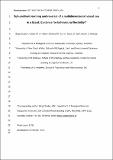Files in this item
Subproblem learning and reversal of a multidimensional visual cue in a lizard : evidence for behavioural flexibility?
Item metadata
| dc.contributor.author | Szabo, Birgit | |
| dc.contributor.author | Noble, Daniel W.A. | |
| dc.contributor.author | Byrne, Richard W. | |
| dc.contributor.author | Tait, David S. | |
| dc.contributor.author | Whiting, Martin J. | |
| dc.date.accessioned | 2019-07-05T23:40:45Z | |
| dc.date.available | 2019-07-05T23:40:45Z | |
| dc.date.issued | 2018-10 | |
| dc.identifier | 255900236 | |
| dc.identifier | ca3427dd-4b13-4988-a50b-0758fa5ae368 | |
| dc.identifier | 85052971550 | |
| dc.identifier | 000446232300004 | |
| dc.identifier.citation | Szabo , B , Noble , D W A , Byrne , R W , Tait , D S & Whiting , M J 2018 , ' Subproblem learning and reversal of a multidimensional visual cue in a lizard : evidence for behavioural flexibility? ' , Animal Behaviour , vol. 144 , pp. 17-26 . https://doi.org/10.1016/j.anbehav.2018.07.018 | en |
| dc.identifier.issn | 0003-3472 | |
| dc.identifier.other | RIS: urn:4ED8B88A4A187FD5051650B2B75271ED | |
| dc.identifier.other | ORCID: /0000-0001-5310-7731/work/60195428 | |
| dc.identifier.other | ORCID: /0000-0001-9862-9373/work/60630529 | |
| dc.identifier.uri | https://hdl.handle.net/10023/18050 | |
| dc.description | This project was funded by an ARC Discovery grant (DP130102998) to Martin Whiting and Richard Byrne and by Macquarie University. | en |
| dc.description.abstract | Behavioural flexibility, the ability to adjust behaviour to environmental change by adapting existing skills to novel situations, is key to coping with, for example, complex social interactions, seasonal changes in food availability or detecting predators. We tested the tree skink, Egernia striolata, a family-living skink from eastern Australia, in a set-shifting paradigm of eight colour/shape discriminations including reversals, an intradimensional acquisition of a new colour/shape and extradimensional shift from colour to shape (and vice versa). Skinks could learn to discriminate between colour/shape pairs and reverse this initial stimulus–reward association; however, they showed no significant decrease in the probability of making a correct choice in the extradimensional shift suggesting that they did not form an attentional set. Subjects appear to have learnt each stage as a new problem instead of generalizing stimuli into specific dimensions (set formation). In conclusion, tree skinks solved a discrimination reversal by focusing their attention towards visual stimuli and flexibly adjusting their choice behaviour accordingly. These lizards learned to use multidimensional visual stimuli to find a food reward but did not generalize stimuli into dimensions. Furthermore, this study is the first to test for set shifting in a lizard species and thereby allows us to extend set-shifting theory to a new taxon for comparison with primates, rodents, a bird and a turtle. | |
| dc.format.extent | 10 | |
| dc.format.extent | 808740 | |
| dc.language.iso | eng | |
| dc.relation.ispartof | Animal Behaviour | en |
| dc.subject | Cognition | en |
| dc.subject | Discrimination learning | en |
| dc.subject | ID/ED task | en |
| dc.subject | Reptile | en |
| dc.subject | Set shifting | en |
| dc.subject | BF Psychology | en |
| dc.subject | QH301 Biology | en |
| dc.subject | NDAS | en |
| dc.subject.lcc | BF | en |
| dc.subject.lcc | QH301 | en |
| dc.title | Subproblem learning and reversal of a multidimensional visual cue in a lizard : evidence for behavioural flexibility? | en |
| dc.type | Journal article | en |
| dc.contributor.institution | University of St Andrews. School of Psychology and Neuroscience | en |
| dc.identifier.doi | https://doi.org/10.1016/j.anbehav.2018.07.018 | |
| dc.description.status | Peer reviewed | en |
| dc.date.embargoedUntil | 2019-07-06 |
This item appears in the following Collection(s)
Items in the St Andrews Research Repository are protected by copyright, with all rights reserved, unless otherwise indicated.

